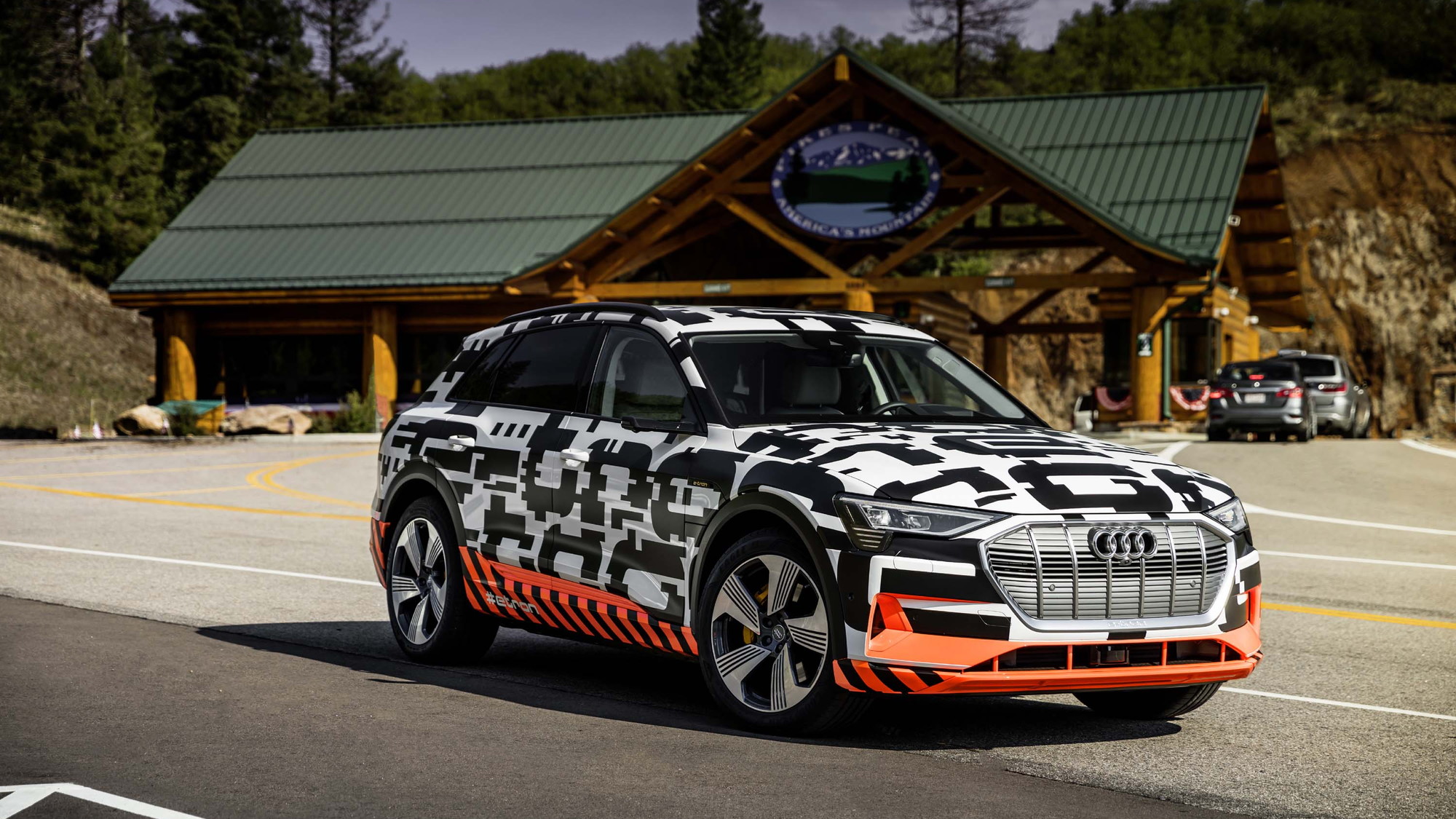Ignore the flashy, high-tech vehicle wrap, a cross between pixelated camouflage and hunting orange. The 2019 Audi e-tron is a non-event from inside, and that’s just what its maker intended.
When it goes on sale next year, the e-tron electric crossover SUV will be the anti-Tesla. Its conservative crossover SUV shape will draw no more and no less attention than the countless leased Audi Q5s that infest big city streets like Japanese beetles mowing down a prized rose bush. Its interior wows with its trio of screens and its dearth of buttons, but then so does the Audi A6 parked across the showroom.
MORE: Reserve a 2019 Audi e-tron following September 17 global debut
From the front seat, where I find myself perched next to bespeckled Audi engineer Oswin Roeder as he gently guides this crossover SUV, everything seems normal.
Well, other than the fact that this comfortable Audi is gliding silently down the buttery smooth pavement at Pikes Peak as the sun rises over our shoulders.

2019 Audi e-tron prototype drive, Pikes Peak
The Audi e-tron prototype I’m riding in has all the hallmarks of a high-end, mid-size crossover SUV. Its doors close with a solid “thunk,” the mix of leather and synthetic suede surfaces feels just right, and its seat heaters are plenty warm for a chilly 32-degree morning at the summit of of a Colorado mountain. A trio of screens handle infotainment, audio, and instrument information. It's all very high-tech, but there's nothing to be found here that doesn't show up in the latest Audi A6 and A8.
The e-tron’s ride quality is firm over the occasional bump in the road, and it’s clear that the 21-inch wheels fitted to the prototype contribute to little lean into corners.
ALSO SEE: No mirrors, just screens: Audi shows off e-tron electric SUV's cockpit
Roeder’s voice barely rises above a whisper as the e-tron snakes down the mountain before tourists begin to arrive. He’s attempting to explain why we didn’t drive up Pikes Peak in the e-tron. The focus of this drive, he tells us, is to show how effective the e-tron is at recuperating power from coasting and from using its unique braking system. In most situations—90 percent, Audi optimistically estimates—the vehicle’s hydraulic braking system, including its pads and rotors, will be charged but not activated. Instead, its two electric motors—one per axle—handle braking until the pedal is pressed extra hard, such as during an emergency maneuver. That’s when the hydraulic system kicks in to bring the e-tron to a halt.
To wit: about halfway down Pikes Peak sits a small hut, where a park ranger uses an infrared thermometer gun to check brake temperatures of every vehicle. The e-tron’s front brakes are barely above the ambient temperature, about 55 degrees at this point.
Flatlander tourists sometimes cook brakes to the tune of 500 degrees.
“We see it all the time,” the park ranger chuckles. “But we smell it first.”
Certainly, Roeder’s careful driving has something to do with the low temperatures. But it’s also a reminder that the e-tron’s electric motors have done nearly all of the braking downhill.

2019 Audi e-tron prototype drive, Pikes Peak
Paddle shifters mounted behind the e-tron’s steering wheel control three levels of recuperation.
Level 0, signified by a tiny marker in the digital instrument cluster, means the e-tron drives like a normal car. Level 1 amps up the electric motors’ deceleration for something closer to one-pedal driving. Two taps of the paddles activates Level 2, which Roeder says is true one-pedal driving.
Not that I know for certain since I spend about half of the drive in the front seat watching him and the other half in the rear seat, which is more capacious than the slightly smaller Audi Q5. I have no idea what the pedal actually feels like.
e-tron practicalities
Using European standards, Audi promises about a 250-mile range for the e-tron with about 30 percent of that coming from expected recuperation. No figure has been released for the U.S., but the e-tron’s charge level increases from about 45 percent when we sat at the mountain’s summit to 55 percent when we complete the 19-mile, 6,200-foot drop.
Pancaked into its floor, the e-tron’s 95-kWh lithium-ion battery supplies power to the twin electric motors—one on each axle. Combined, they produce 265 kW (about 355 horsepower) and about 414 pound-feet of torque.
Roeder snakes the transmission lever into Sport mode by tapping it backwards and mashes the throttle pedal to the floor. The e-tron vaults forward with authority. Without warning us, Roeder activated the 8-second “boost mode” that fires up nearly 490 pound-feet of torque.
He brakes hard this time, and the e-tron jolts to a stop before the ABS engages. This time, the e-tron activated its hydraulic brakes.
Roeder says he didn’t feel any difference in the pedal, but again I’m forced to trust him since I won’t get my chance behind the wheel until closer to the e-tron’s on-sale date targeted for the first half of 2019.
He also tells us that the system can react faster than normal brake-by-wire systems, so automatic emergency braking happens even faster. In this case, I’m fine with not testing things out. After all, not every drive needs to be an event. Just like the Audi e-tron.
Audi provided travel and lodging to Internet Brands Automotive to bring you this firsthand report





